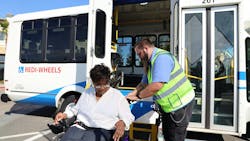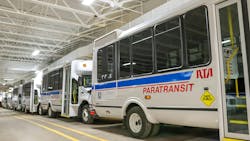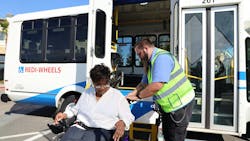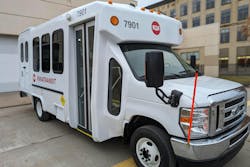Paratransit Improvements Essential to Customer Experience
It was an early June night in my hometown of Cleveland, Ohio, during the 2024 American Public Transportation Association’s Rail Conference. I was using the Greater Cleveland Regional Transit Authority’s (GCRTA) paratransit service to meet the Mass Transit team downtown for dinner. We had scheduled to meet downtown at the restaurant Fahrenheit in Public Square. My paratransit driver dropped me off at Tower City, an approximate three-minute walk from the restaurant, as the address given to him was the Fahrenheit restaurant located in Tower City, not the one in Public Square. The driver told me he could not change my drop-off address, so I had to navigate the rest of the way myself.
The next day, another incident occurred on my way home from the APTA Rail Conference. It was me, the driver and another passenger. As we turn down my street, we drive right past my house. I told the driver he missed my street. I vividly remember the words he uttered to me next, “Oh, I didn’t know that! The GPS is telling me to drop her off first. If I had known this was your street, I would have dropped you off first. This happens all the time.”
I was picked up from downtown Cleveland after the APTA Rail Conference at approximately 5:10. I did not arrive back at my residence until 6:30. On a heavy traffic day, I am located 20 minutes away from the Huntington Convention Center.
As a paratransit rider and a journalist covering the public transit industry, I saw a unique opportunity to connect my personal experiences and what I think could be improved with my knowledge of how the industry operates and the challenges it faces that the average rider may not understand. Mass Transit does not typically center first-person features; however, this is a piece I’ve wanted to write for a while because I want this piece to provide a solution to improve paratransit, not only in Cleveland, but across North America. I want every paratransit ride to be a positive experience.
I wanted to give my perspective as a user, but I also wanted to talk to GCRTA about its paratransit program, a GCRTA paratransit rider to get another perspective and another paratransit service outside of GCRTA to cover what paratransit systems are doing to better their services throughout the U.S.
While conducting my interviews for this feature, there were two main issues that came up when it came to paratransit:
- Scheduling/tracking rides
- Route selections
Scheduling/tracking rides
When riders schedule a ride with GCRTA, the scheduling system schedules a 30-minute pick-up and drop-off window for each individual trip. Nick Davidson, GCRTA’s paratransit district director, notes the scheduling system intelligently selects a window based on the trip's direct travel time and says the goal of the system is to ensure a rider arrives at their destination within a reasonable amount of time, not too early and not too late.
Jen Taggart uses the GCRTA paratransit system on average four times per week for grocery store runs, medical appointments, work and leisure activities. Taggart says she feels GCRTA is on time for her needs more often than not.
“I’ve been early way more often than I have been late to things using paratransit,” Taggart noted, while claiming her strategy for scheduling rides is to plan an hour ahead to give herself and paratransit plenty of time.
In California, San Mateo County Transit District (SamTrans) launched its same-day paratransit pilot program in December 2023. The program allows riders to ask for a same-day paratransit trip within San Mateo County between 9:30 a.m. and 6:00 p.m. during weekdays. The dispatchers at the scheduling center attempt to schedule the trip within 90 minutes of the requested time.
On Dec. 5, 2024, the SamTrans Board approved the same-day paratransit pilot program to become part of the suite of mobility services.
Tina Dubost, SamTrans’ manager of accessible transit services, says riders have been asking for same-day service for a long time.
“Things come up at the last minute that you have unexpected trip needs. We are offering the service on a space available basis so we're making better use of our existing capacity,” Dubost said.
The same-day paratransit service costs more to ride ($10 per ride, $8 for reduced fare) compared to SamTrans’ regular paratransit service ($4.25 per ride, $1.75 for reduced fare). Dubost says early data shows ridership is about the same compared to regular paratransit service so she feels the price is not too high. SamTrans has provided 896 rides to 309 different riders since December 2023.
While GCRTA does not offer same-day paratransit services the way SamTrans does, the agency launched an updated online scheduling platform on Oct. 7 for riders to schedule their rides through GCRTA’s website. The old platform was outdated and would constantly bug out, not allowing riders to see their rides from the platform, as well as schedule rides to certain locations. The issues forced most riders (including myself) to call in their rides, which becomes frustrating to someone who wants 24/7 access to view their rides.
Both Davidson and Taggart agree the new system will help the scheduling process.
“This was a longer process than I would have liked but we wanted to make sure that we delivered it and tested it thoroughly,” Davidson said. “We got it right and corrected some items from our old system, as well as updating the technology. It'll provide a better customer experience for our customers. Our customers have busy lives and this will provide 24-hour access to our scheduling system and help free up our call system.”
“It's gonna be a huge time saver and I'm glad that now I can see my rides on the website,” Taggart noted. “Short-term, it’s an adjustment, but long-term it's gonna be a great thing.”
While the updated platform provides more convenience for scheduling rides, Taggart says she wishes there was a way to track rides, such as an Uber or Lyft, to provide more flexibility. This, she says, would help her not have to leave a social outing or work early because she thought her paratransit ride was on the way.
“That would kind of give you the time back if you could look at your phone and be like, ‘Oh they're still half an hour away,’ then you can go back and do whatever you were doing, whether it was working, whether it was sitting at a table eating with your friends,” Taggart said.
Davidson understands the need and says it’s something that’s on the way.
“We've earmarked funds for a mobile app, which will have all of that information, as well as being able to track the bus as it's coming to you,” Davidson said. “We expect that in approximately a year from now, we'll have that option available for our customers so that they can interact with public transit the same way that they do with other businesses.”
Dubost notes SamTrans is just using the call center currently to schedule rides. She notes scheduling rides over the phone works for the agency currently and there is not an app in development.
Route software/route making
On-time performance is as critical as having flexibility in scheduling and managing a trip. Trips that take double or triple the amount of time to complete can be a frustrating experience for riders.
Taggart had a night on paratransit she will never forget in 2022. She was leaving a social outing at approximately 9:00 p.m. On her way home, she and another passenger had to go pick up another rider downtown at the Cleveland Guardians baseball game, 20 minutes the other direction from Taggart’s residence. Taggart said that when the paratransit vehicle arrived to pick up the passenger, the passenger was not at his pick-up location. Taggart notes it took almost two hours to find the passenger, an experience she, nor the driver, will ever forget.
“That was my one wild paratransit story,” Taggart said. “I was on that bus for nearly three hours.”
According to Davidson, GCRTA’s route-making system takes into account several factors, including pick-up and drop-off windows and appointment times. The average on-time arrivals and drop-offs occur 30 minutes before/after an appointment time. He notes drivers have the ability to change routes if they feel the need to, but that need comes with experience.
“If an operator were to believe that the order of trips should be different or a customer requests to be dropped off first or whatever the scenario is, they would call dispatch and we would evaluate that and make that change when possible,” Davidson said.
Dubost says SamTrans’ route scheduling system is “quite sophisticated” and takes into account factors such as:
- Pick-up time
- Appointment time
- Approximate travel time
She says she tells riders to schedule rides by their appointment time to ensure they arrive at their destination on time.
Dubost notes she expected the same-day paratransit pilot to be used mostly for medical cases but the data reveals something different.
“Medical appointments are less than 40 percent of our same-day trips,” Dubost said. “We do restaurant trips. We do grocery runs. We do nail salons. This really is life enhancing.”
Conclusion
Paratransit is essential to riders with all sorts of disabilities — physical, mental and emotional. It can be a lifeline for them to get from place to place. Paratransit has allowed me, someone with a physical disability, to be more independent in my day-to-day life.
GCRTA and SamTrans, as well as other paratransit systems across North America, are working to improve paratransit services the same way agencies are constantly working to improve fixed-route service.
GCRTA is focused on offering a better scheduling system for riders with its new online portal, as well as developing an in-house app where riders can track their rides 24/7. Meanwhile, now that SamTrans' same-day pilot program is part of the agency's suite of mobility services, SamTrans is looking to continue the success of its same-day system for years to come.
The improvements to ride tracking, pick up/drop-off windows and route selections is just the start to what paratransit may look like across North America within the next half decade.
About the Author
Brandon Lewis
Associate Editor
Brandon Lewis is a recent graduate of Kent State University with a bachelor’s degree in journalism. Lewis is a former freelance editorial assistant at Vehicle Service Pros in Endeavor Business Media’s Vehicle Repair Group. Lewis brings his knowledge of web managing, copyediting and SEO practices to Mass Transit Magazine as an associate editor. He is also a co-host of the Infrastructure Technology Podcast.




